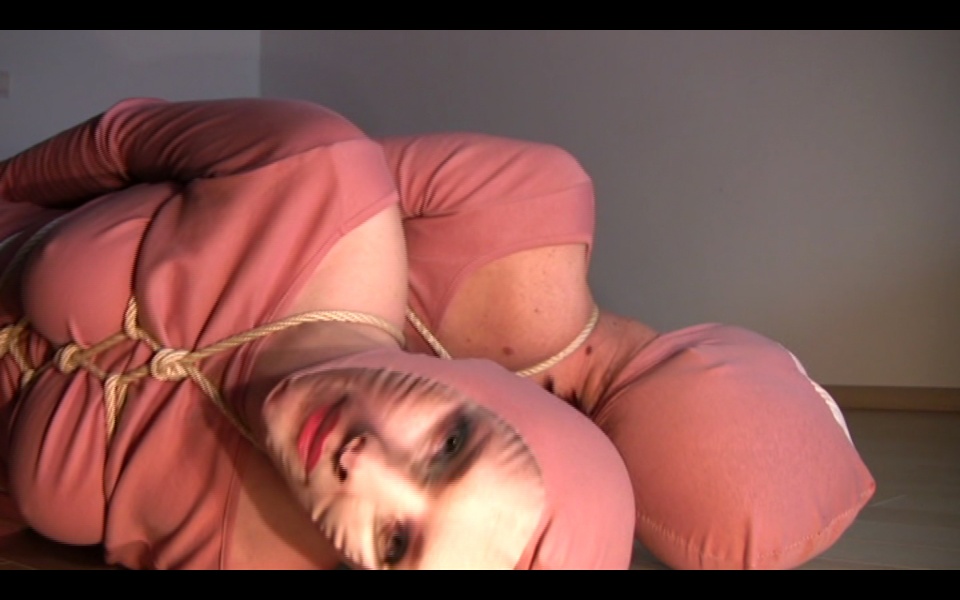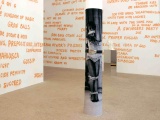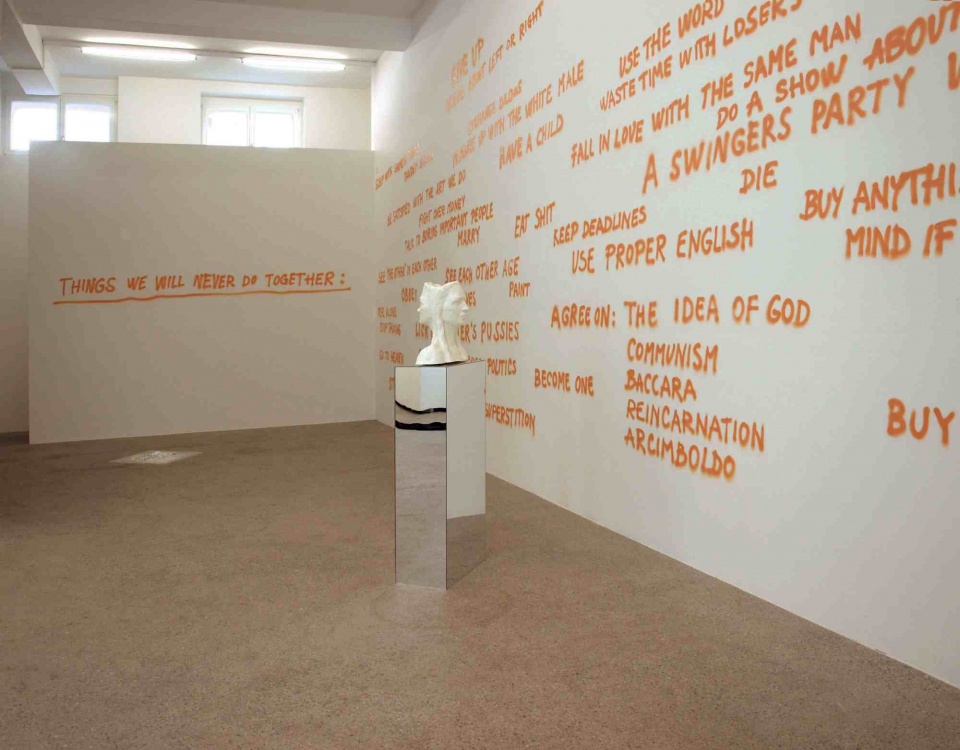Anetta Mona Chisa & Lucia Tkacova, 2 June 2012 – 14 July 2012

Never Odd or Even, still from the video, 2011
i aM a venus, A conch, a kiT, a Cat, a Lot
OPENING FRIDAY JUNE 1, 6-8 pm, 2012
In his esteemed work, Politiques de l’amitié, Jacques Derrida elaborates on the social bonds developed over the course of the Western tradition, which he identifies as forms of loving and desire, quest and promise, consensus and respect for the Other that are not determined by familial ties or ideological solidarity: friendships. However, in our culture the “philosophical paradigm of friendship” reflects “the double exclusion of the feminine …that can be seen at work in all the great ethico-politico-philosophical discourses on friendship, namely, on the one hand, the exclusion of friendship between women, and, on the other hand, the exclusion of friendship between a man and a woman.” In the non-hierarchical schema of male friendships, where the figure of the father is excluded and the figure of the brother privileged, the feminine is (made) absent, so Derrida, much in the way that Nietzsche—adhering to this familiar heteronormative and misogynic framework—asserted that woman is “not yet” capable of friendship since she “only knows love.” This does not mean that in our culture women are incapable of establishing a politics of female friendships but merely that relationships between women have “not yet” been given proper theoretical framing. On the one hand, recent scholarship has begun to focus on couples who share a sexual (primarily heterosexual) and creative partnership, in which women appear as “significant others;” feminist authors often theorize the complexities enmeshed in lesbian and gay creative couples; and feminist film and media theories address the “minimal communities” consisting of two women engaged in doing-something together, such as the “female buddies” that have emerged since the early 1970s in “low” mass media, motion pictures, and television—promptly labeled “bitch media.” On the other, it is almost impossible to find any truly relevant piece of writing that would theorize female buddies who make “high” art together. As throughout history, today female art-buddies are a quite seldom phenomenon.
In 2000 Anetta Mona Chisa and Lucia Tkacova establish their collaborative practice, deciding to do “a piece on the road together”. Over the course of the twelve years that followed they are to remain a party of two, in which they do not engage with each other as a couple but as a pair. A year after they met they produced a video piece indicatively entitled Les amies (Girlfriends, 2000), which does not, however, explicitly deal with their own friendship. Instead it offers a feminist look at a liaison between a girlish-looking woman and a doll, a huge Barbie, which suggests the woman as both consumer and consumed (as an image). It also comically counters the notion of femininity as based on the familiar fiction of “diamonds are a girl’s best friend” while drawing on the revamped image of the 1990s “IT-girl.” And even though this piece is technically raw in comparison their later, more “polished” artworks, it touches on many issues that recur in their art later on: a critique of commodity and the entire spectrum of neoliberal capitalism, the way women are forced into stereotypes, and the role of the authoritative gaze in the consumption of art. Soon they begin to address the mechanisms of the art system to which they belong, asking unpleasant questions about its working processes and impact, as in they did in Romanian pavilion at the Venice Biennial of 2011. What has defined and solidified their friendship—in life and in art—is their sense of humor and their unmatched capacity for self-irony. Indeed, in their work laughter functions as critical mechanism, not merely as a source of enjoyment.
One could parallel their relationship with similar confidential bonds between women, for example the “epistolary romances” between Hannah Arendt and Mary McCarthty. It was based on solidarity, mutual commitment, and occasional creative cooperation, but before all on tenderness. It was “a friendship that border[ed] on romance, not sexual romance, but not entirely platonic either” since they both longed for each other’s physical presence (Carol Brightman). Given that Chisa and Tkacova do not live in the same city, they are inevitably forced to carry on an “email romance,” but apart from being “just friends”, they need each other’s presence in order to make their art. Physical togetherness and the joy of working together come through in many of their (video) works, which convey closeness, nearness, and tenderness, as if the camera were not there—as in the conversational videos Dialectics of Subjection # 21 (2004), Dialectics of Subjection # 2 (2005) and Dialectics of Subjection # 4 (2006), in which they size up male artists, curators, and politicians according to their sex appeal. Making art together and, in particular, exhibiting together necessarily brings about “the institutionalization of friendship,” a term which Victor Misiano applies solely to collaborations between male artists. In joining the institution of art as a female duo, Chisa and Tkacova have introduced a politics of female friendship: it is a politics of difference not because it implicitly alludes to the overt presence of “boys-clubs” in the art system (today as in the past), but it also implies difference as did the notion of “feminissance,” which hit the art world during the 1990s. On a global scope, one has a hard time finding a female duet continuously engaged in cooperative work in today’s art scenes. Presumably fearing “ghettoization”, women artists of Chisa and Tkacova’s generation are often heard claiming: “I am not a feminist, but …”
In contrast, the politics of friendship introduced by Chisa and Tkacova is informed by their feminist positioning, which follows two basic trajectories viewed by Theresa de Lauretis as central to (the history of) feminism. The first is a narcissistic drive for self-representation. This may imply taking on the identity of “disorderly” and “unruly women” (Russo), using the strategy of “womanliness as masquerade,” subversion and excess, as in their Porn series of posters (2004–2007) and Porn Video, 2004 (where they are, however, decently dressed). Here they work with the stereotypical equation of women with sexuality, playfully but ironically replaying a scene in which they as women assume the stance and appearance of “to-be-looked-at-ness” (Mulvey). At the same, in acting out this scene they reject powerless, victimization, and subjugation. The other feminist trajectory is the ethics of working together, sharing, and trust. Chisa and Tkacova obviously denounce the production of “monologic” art on which the entire framework of the Western (art) tradition of individualism is based. Instead they opt for what Mikhail Bakhtin calls a “dialogic work.” A dialogic matrix runs through all their works, although it is always differently articulated. A primary element of dialogue is evident in the fact that they engage with each other as artists-friends who jointly make art. The second is manifested in their examination of female traditions and historical women’s movements, thus establishing a kind female a genealogy, in which the radical socialist and anarchist tradition of rebellion is informed by an anti-capitalist stance. Finally, as in their current exhibition, they refer to a “tradition without tradition,” that is the alliances between two women buddies as developed in popular culture, film, literature, rock music, and comics, such as Thelma and Louise, Xena and Gabrielle, Annabel and Midge, Marie Corrençon and Jeanne Salève, or Baccara. Finally, the dialogic element to their work has a literal component, since many of their works are staged as conversations between the artists.
Since twelve years Anetta Mona Chisa and Lucia Tkacova have been engaged in a politics of friendship that requires an ongoing negotiation of their artistic identities as well as the narcissism that this implies. It demands the constant restraint of their otherwise strong individualism (without which the cooperation would not be possible) and a balance in the power relations that inevitably resurface in every collaborative process.
Such cooperation always implies a vacillation between “I-for-myself” and “I-for-another,” which they address in the recent work The Others (2011), where they appear wearing masks of each other’s faces. This visual blending of “me” and “you” plays on the common significance of the photographic portrait as a visual sign suggesting an individual’s unique identity, but undermine it, since the photographic portrait is itself a mask. The video Never Odd or Even (2011) explores the desire for and fiction of complementarity in a quite different manner. Using the technique of self-bondage, the artists perform the notion of “intercorporeality” (Merleau-Ponty), which is here enabled through the sense of the touch (and not by the authoritative eye, as in photography). In this performance, the symmetry inherent to the number two—two artists, two women, two selves, two touching bodies made immobile and even subjected to physical pain—appears to be tested and even called into question. This testing scenario results in what could be called the third, a central idea for Chisa and Tkacova’s politics of friendship in general: “The ‘third’ is a mode of articulation, a way of describing a space of possibility. Three puts in question the idea of one: of identity, self-sufficiency, self-knowledge.” (Marjorie Garber)
Text: Bojana Pejic´














